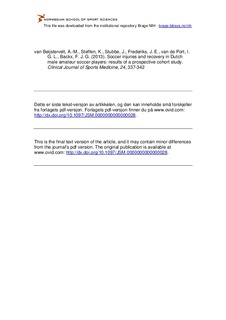| dc.contributor.author | van Beijsterveldt, Anne-Marie | |
| dc.contributor.author | Steffen, Kathrin | |
| dc.contributor.author | Stubbe, Janine | |
| dc.contributor.author | Frederiks, Janet E. | |
| dc.contributor.author | van de Port, Ingrid G. L. | |
| dc.contributor.author | Backx, Frank J. G. | |
| dc.date.accessioned | 2015-08-06T10:28:35Z | |
| dc.date.available | 2015-08-06T10:28:35Z | |
| dc.date.issued | 2014-07 | |
| dc.identifier.citation | Clinical Journal of Sport Medicine. 2014, 24, 337-342 | nb_NO |
| dc.identifier.uri | http://hdl.handle.net/11250/295168 | |
| dc.description | I Brage finner du siste tekst-versjon av artikkelen, og den kan inneholde ubetydelige forskjeller fra forlagets pdf-versjon. Forlagets pdf-versjon finner du på www.lww.com: http://dx.doi.org/10.1097/JSM.0000000000000028 / In Brage you'll find the final text version of the article, and it may contain insignificant differences from the journal's pdf version. The definitive version is available at www.lww.com: http://dx.doi.org/10.1097/JSM.0000000000000028 | nb_NO |
| dc.description.abstract | Objective: To describe characteristics of outdoor soccer injury and recovery among Dutch soccer players.
Design: Prospective cohort study.
Setting: The 2009-2010 competitive season (33 weeks).
Participants: Four hundred fifty-six Dutch male soccer players of 23 amateur teams.
Main Outcome Measures: Coaches recorded individual exposure to all soccer activities. Paramedics or sports trainers collected information on the occurrence (eg, location, type, circumstances) and consequences (eg, absenteeism, medical treatment) of injuries.
Results: In total, 424 time-loss injuries were sustained by 60% (n = 274) of the players, with 23% (n = 105) having more than 1 injury. This corresponds to an overall density of 9.6 (8.7-10.5) injuries per 1000 player hours; 3.9 (3.3-4.7) in training sessions and 20.4 (18.1-23.1) in soccer matches. Almost 30% (n = 123) of the injuries lasted for more than 1 month, 14% (n = 58) were reinjuries (causing longer absence than new injuries), and 54% (n = 230) of the injuries were given medical treatment. The most common diagnoses were muscle/tendon (38%) or joint/ligament injuries (23%) of the lower extremities. After regaining the ability to fully take part in soccer training or matches, 27.4% of the players (n = 116) still reported complaints.
Conclusions: Two recommendations based on the above-mentioned results are (1) prevention should primarily focus on these most common diagnoses and (2) players resuming soccer activities after an injury should be given special attention to resolve the remaining complaints and to prevent reinjuries. | nb_NO |
| dc.language.iso | eng | nb_NO |
| dc.publisher | LWW | nb_NO |
| dc.subject | soccer | nb_NO |
| dc.subject | injuries | nb_NO |
| dc.subject | recovery | nb_NO |
| dc.subject | epidemiology | nb_NO |
| dc.subject | amateur | nb_NO |
| dc.subject | incidence | nb_NO |
| dc.title | Soccer injuries and recovery in Dutch male amateur soccer players: results of a prospective cohort study | nb_NO |
| dc.type | Journal article | nb_NO |
| dc.type | Peer reviewed | nb_NO |
| dc.subject.nsi | VDP::Medical disciplines: 700::Sports medicine: 850 | nb_NO |
| dc.source.journal | Clinical Journal of Sport Medicine | nb_NO |
| dc.description.localcode | Seksjon for idretssmedisinske fag / Department of Sports Medicine | nb_NO |
